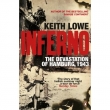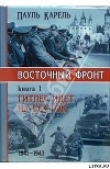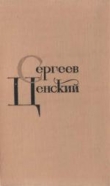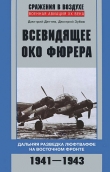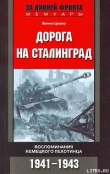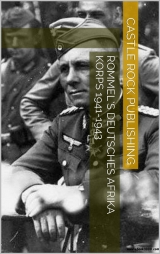
Текст книги "Rommel's Deutsches Afrika Korps 1941-1943"
Автор книги: Автор Неизвестен
Жанры:
История
,сообщить о нарушении
Текущая страница: 2 (всего у книги 19 страниц)
On the question of who was to command the Africa Corps Hitler selected Genera! Rommel, who had been commander of his Escort Regiment during the campaign in Poland and on 7 February he briefed the new Corps commander on his tasks, the most important of which was to hold Tripolitania at all costs.
The German troops who disembarked in Tripoli on 11 February were followed by the first fighting units three days later. These men were the advanced guard of a force which was to be known by many titles, the one which it retained longest being that of Panzer Army Africa, but which is more famous for the name which it held only a relatively short time – Africa Corps.
The tasks, responsibilities, and duties of this formation had been worked out by Hitler and Commando Supremo and included within the terms of reference were the following:
(1) For tactical purposes the general officer commanding German troops is subordinate to the Italian Supreme Command in Libya. He is responsible to OKH for all other decisions,
(2) German troops may only be used as complete units ...
(3) German troops may not be distributed in small groups along the front.
(4) In the event of the German commander being given an order which, in his opinion, could lead to his force being lost then he had the right and duty to ask for Hitler's decision, although he must inform the Italian High Command that he is making this appeal.
(5) The Xth Air Corps remains under the command of supreme commander Luftwaffe and is to collaborate with the Italian Air Force.
On 9 February 1941, a conference between Mussolini and von Rintelen led to Mussolini accepting Rommel as commander of the joint German/Italian mobile forces and on the same day came the announcement that Mussolini had replaced Graziani by Gariboldi, the former commander of the Italian 5th Army. The Axis leader confirmed Hitler's intention that Tripolitania was to be defended by aggressive defence in the Sirte. Rommel then flew to Rome on 11 February for a conference with Mussolini and, in the afternoon of the same day, went on to Sicily for a briefing on the situation in Libya by Xth Air Corps commander. By the following day Rommel was in Africa learning at first hand of the serious situation in which the Italian Army was placed.
He flew back to Germany and laid before Hitler his plans on the course of the operations which he intended to conduct in a counter-offensive to reconquer Cyrenaica. He proposed to wait and to hold the blocking line until his two German divisions, 5th Light and 15th Panzer, had arrived and then together with the Italian armoured division Ariete and the motorised division Trento he would attack the British. Rommel was not aware and neither were his superiors at OKW nor Commando Supremo that Wavell had been ordered to give active military support to the Greeks and that, even as Rommel descended upon Africa once again, an expeditionary force drawn from the British desert army was preparing to leave for Greece, leaving only a thin screen to garrison the conquered territories and to watch the badly shaken Italian armies.
The Desert
The previous chapter has stated how 3rd Panzer Division was to be a nucleus in the Africa Corps organisation and that how, within six months, an expeditionary force had been selected, had been stood down, a new unit reformed, despatched, and was ready for action. In view of the urgency there had been little time for preparation and the German Army in undertaking a campaign in tropical desert regions was entering very much into terra incognita. With the exception of reports based upon the experiences of von Lettow-Vorbeck's force, which had fought in equatorial Africa during the First World War, and upon the recollections of veterans who had fought with the Turks in Palestine, there were no first hand experiences upon which the staff could make their plans.
Not until after the armistice with the French did discussions take place on the subject of equipment and supply for units serving in sub-tropical or tropical climes and, once again, contemporary information was lacking. There were no French or British papers dealing with the tactics or employment of motorised or armoured formations in desert warfare and the Italian material had, generally, dealt only with the recently concluded war against Ethiopia. In the autumn of 1940 the Italians produced their first reports based upon the campaign against the British in Egypt but these papers were lacking in detail, were often inaccurate in report, and frequently as wildly false as the maps which their cartographic service had produced. Basic and sometimes vital details were omitted from the Italian reports so that the first German units were supplied with unnecessary or badly designed equipment.
A case in point was the fact that upon Italian recommendation the Germans sent no diesel engines to Africa, although in tropical conditions the diesel was a more suitable engine than the petrol motor. The Italians also forgot to add that they had themselves designed a successful, special tropical pattern diesel. With no advice forthcoming the Germans made no special preparations to protect vehicle motors from the scouring effects of sand and dust, so that in the early months the life of a German tank engine was between 800 and 1000 miles, that is about half that of a British vehicle. It was only when special filters were fitted that the life span was increased to equal that of British machines.
The adverse effects upon the efficiency of tank engines of the great heat during the summer campaigns could not be completely overcome by mechanical means and it was found that there were less troubles if marches were undertaken by night or the vehicles moved in the cooler hours of early morning or late evening. Of course, night marches demanded the ability to read the compass efficiently and all tank crews had to be trained in this skill. An added advantage of this training and one which was only later appreciated was that panzer operations could then still be carried out even in the artificial darkness of a sand storm.
Experience was to show that during a tank battle the onset of darkness usually brought an end to the day's fighting and the post-battle actions of the combatants are interesting. The British almost invariably drew back from the battlefield to laager, to rearm, and to prepare for the morrow. Thus, after the strain of battle British tank drivers still had to undertake a march and then on the next day had an approach march to battle. This voiding of the field by the British meant that vehicles which had fallen out or were only suffering from slight mechanical faults were left in German dominated territory for that army, by contrast, laagered on or very close to the scene of the fighting and thus spared their drivers the extra strain imposed in driving.
The German tank recovery organisation was first class and its units followed close behind each panzer company ready to carry out, under fire, local and immediate repairs. For the more seriously damaged vehicles there were low-loader trucks able to bear weights of up to 18 tons and thus able to remove such tanks from the field to the workshops immediately behind the firing line so that specialised repairs could be carried out on them. Such organisation, much improvisation, and as a result of such practices the Axis forces were able to overcome the numerical inferiority from which they suffered. They further reduced the superiority of their enemy by taking into their own service or by blowing up the British tanks which had been left unrecovered on the field. [2]
The Italians were unable to give any details on camouflage, a difficult task in an area devoid of all natural cover, and the Germans tried many methods of concealment. The first vehicles to arrive in North Africa had been covered in standard European paint for the quartermaster's department had no paint suitable for desert conditions. To tone down the shades of grey and green the machines were first sprayed with oil and upon this foundation sand was strewn. The greatest need in all concealment is to break up the outline of the shadow which the vehicle casts and to do this extensive use was made of netting, sometimes set about with small tufts of camel thorn. The method which the infantry frequently used to escape detection was to dig slit trenches into the sides of wadis or if in the open desert then to spread a net across the trench opening and thus to have not only protection against detection but shade from the sun.

Not even by night were vehicles safe from detection for bright, desert moonlight illuminated them at considerable distances even from the air and it was necessary, therefore, for vehicles to move tactically dispersed when travelling in moonlight. In addition to camouflage against visibility, units concealed their locations and avoided being surprised during the hours of darkness or in periods of rest by practising wireless silence. Any message which it was essential to pass went out either on the ultra short-wave wireless frequency to avoid interception or by telephone, although this latter method was only used inside a laager during long halts or at night.
Very little information was available on the effect of tropical living upon northern Europeans although it was widely held at OKH that the summer heat would be too great to allow military operations to continue and that both armies would withdraw into summer quarters to await better campaigning weather, just as the armies had taken up winter quarters in cold climates in former days. Having no data the Germans made no special selection of men to serve in Africa, other than a simple medical examination. Nor was any special training given or, in the early days, any time spent in acclimatisation. By an unplanned piece of good fortune the first troops arrived in early spring and needed no period of acclimatisation before going into battle within weeks of their debarkation. Subsequently, reinforcements were sent to Bavaria or to Sicily to accustom them to the heat but still no special training or instructions were given other than a few lectures on hygiene.
These statements conflict with contemporary British newspaper accounts which described how hordes of blond stormtroops, the recruits for the Africa Corps, had been set to marching in vast glass, hothouses set up on Baltic beaches to prepare them for the great heat: the difficult, airless, and arid conditions under which they would live and fight in Africa. This legend of the highly trained supermen helped to salve British wounds inflicted when Rommel's small force beat the remnants of Wavell's Army, depleted by the removal of much of its strength to serve as an expeditionary force in Greece.
One of the most important requirements in the African campaign was the ability to identify quickly and at long range men or vehicles encountered in the desert and in this field, too, the Germans had to learn from experience. The effect of sun upon sand caused severe eye strain – a form of sand blindness -often produced mirages, and always shimmering heat waves. All or any one of these reduced the range of effective vision and thus the ability to identify vehicles with speed. In open desert vision was only slightly affected between the hours from first light to about 09.00hrs and from 16,00hrs to dusk. At those times accurate vision varied between 2000 and 5000 yards. As the day wore on and the temperature rose the effective range decreased to less than 1500 yards.
It should have been apparent to the German planners, but seems to have escaped their notice, that North Africa is, by and large, a treeless waste. Yet they made no attempt to supply fuel oil for cooking or for workshop firing and relied on wood which had to be brought from Italy thus reducing shipping space which could have been used for more vital supplies. They were also unaware that the desert terrain is not a vast series of sand dunes as a result of which the lorries fitted with double tyres for better traction in such conditions suffered from punctures caused by the infiltration of sharp stones picked up and wedged between the double tyres when the vehicles crossed the hard-going which constituted much of the desert's surface. Later during the campaign special wide tyres were fitted to the Volkswagen cars and thereby improved the cross-country performances of those vehicles.
By and large it can be said that the Italians did nothing to prepare themselves for a desert campaign and that the Germans were unable to do anything through lack of time and foreknowledge. But it must also be admitted that once there were experiences upon which to base conclusions or to make appreciations then Rommel's force adapted, improvised, and fought a good fight.
On the problem of food suitable for soldiers in tropical areas the Germans, again lacking first-hand information, drew very heavily upon out of date sources and upon theories. The dieticians issued instructions on the type and preparation of food that were completely at variance with available resources and showed little forward planning and even less imagination. They were convinced that potatoes, the German soldier's staple diet and bread, his other basic foodstuff, were liable to spoil and turn mouldy in the North African climate. Substitutes for these two basic foods were issued: beans in place of potatoes and biscuits in place of bread. The British Army which faced the same problem had solved the potato question by canning those vegetables, a solution which the German scientists seem not to have considered. In the event German field bakeries began to turn out a flat type of rye biscuit but then went over to baking real bread. Experiments were made using sea water, to economise on sweet water supplies, but these proved unsuccessful.
In view of the fact that butter or margarine melted in the heat, olive oil was used as a substitute and with the exception of small amounts of cheese and tinned beef there were no other ration foods available. The diet was monotonous and lacked not only variety but vitamin C.
With typical German attention to detail instructions were given on how to prepare freshly killed meat or game, on hygiene, on the fact that water should be drunk only during the cool periods of the day, on sanitation, and on relations with the local population. For the greatest part of the years they spent in Africa the German soldiers had little fresh meat, of game there was no sign, the hygiene instructions were commonsense, and it was difficult to establish relations with the Arabs. Those in the populated coastal areas avoided contact and there were few dwellers in the desert places. In later years, in Tunisia, there was such a rapport that native battalions were raised but these men had, perhaps, enlisted more as an anti-French gesture than as a demonstration of pro-German feeling. The Germans certainly made great efforts to win the friendship of the Arabs for their commanders knew that with such support they were assured of a freedom from guerrilla warfare, from partisans, and from sabotage.
Uniforms
The uniform with which the Army in Africa is most closely identified – the long visored cap, the shorts, and high boots – was a development of a pattern of clothing of which the first issues were made late in 1940. The material was an olive-coloured cotton cloth and the cut was the same for all the ranks. The tunic was a lighter version of the standard European pattern garment and the breeches were intended to be worn with the specially designed leather and canvas high, lace-up boots. A sun helmet was covered with olive green canvas and was fitted with light alloy decais of the same pattern as that painted on the steel helmet.
Practical use showed the uniform to be badly designed. The jacket restricted movement and the breeches were.too tight, the sun helmet was too bulky for front line use and gave almost no protection against head wounds. A second disadvantage with the sun helmet was that sand and dust entered the ventilation holes and matted the hair. Only the boots were practical and long lasting.
In the course of time the Germans became aware that it was possible to survive and even fight in the desert during the hottest months of the year so long as clothing was light, loose, and comfortable. The impractical uniform which had been issued was either discarded or amended. The sun helmet was the first item to go and to be replaced by the long-visored field cap, and the steel helmet was brought back for front line use. The tight breeches were discarded and were replaced either by slacks, paratroop overalls buttoning at the ankle, or by short trousers. These latter were not authorised wear in every unit for some regimental officers realised that long trousers gave better protection to the legs against small, accidental cuts and grazes which quickly and almost invariably turned ulcerous.
After long wear and frequent washings the German olive green uniform colour, tended to fade to the shade of khaki worn by the British and when in 1942 vast stocks of British uniforms were captured in Tobruk these were adapted and issued to German units so that on some sectors, except for the rank insignia and specialist badges, both sides wore the same pattern uniform. This use of enemy clothing was not a new phenomenon – equipment and vehicles in particular were often captured and put into service against their former owners. The British had in this fashion used Italian tanks captured during WavelTs offensive, Rommel's command vehicle was a British truck, and after the Mechili operation the captured British soft-skinned vehicles had been issued to the German units to give them a greater mobility. Under such circumstances it is not surprising that most soldiers had great difficulty in correctly distinguishing friendly from enemy units although to aid identification British vehicles in Axis service were frequently marked with a swastika flag and almost always painted with a German straight-edged, black cross.
Terrain
Mention has already been made of the fact that the Germans, in a false assessment of the terrain conditions, sent trucks with double sets of tyres to the African theatre of operations. It is a common fallacy, and one which was held by the OKH, that the whole of the North African desert was a vast sea of loose sand formed into rolling dunes.
There were, of course, large stretches of country in which this condition obtained but the desert also had more areas of firm going on which rocks of varying sizes were met and when in later years the Axis armies entered Tunisia they were climatically in an area akin to southern Italy with mountains, vegetation, and cacti. There was in Libya only one single, all-weather road, the Via Balbia, which traversed the country extending from the Tunisian frontier to Egypt and upon this tarmac surface traffic could move as swiftly as in Europe. The Via Balbia was one of the factors which determined the success or failure of an offensive and it followed very closely the line of the Mediterranean linking, in its west to east journey along the coast, the widely spaced towns and settlements of the Italian colony for there were no important inland towns. The distances between the towns was enormous and it was, therefore, upon a battlefield of vast lateral extent that the campaign was fought out. From Tripoli, the capital city, to Buerat on the eastern border of the province was more than 300 miles. To El Agheila, on the south-western edge of Cyrenaica, it was 470 miles, Benghasi was 650 miles away, and the Egyptian frontier was nearly 1000 miles distant.
Criss-crossing the desert were native tracks (trigh) with varying degrees of value as roads capable of bearing military traffic. Most of these trigh were on firm going but with constant use the hard surface rutted and the trigh widened as drivers left the original track to find smoother going or a less dusty surface. These tracks were useless in wet weather for rain washed away their surfaces and wheeled transport using them frequently bogged down. At a point where two trigh crossed there was usually some sort of landmark, a bir (well or cistern) or sidi (the grave of some Muslim saint). These track junctions played an important part in the fighting for they were landmarks or points of reference in a countryside totally devoid of distinctive features. Such strategically important places were usually held by a garrison or used as advanced supply depots.
A thin, fertile strip of land in which much of the population lived and which bordered the Mediterranean extended into the desert for only a short way and then, as the vegetation ended, the hard surface was met. Farther inland the going deteriorated and there were vast sand seas which were almost impassable, even to tracked vehicles. It was into these isolated and barren wastes that long-distance reconnaissance patrols were sent at infrequent intervals and it was the presence of these great impassable seas which prevented the deployment of masses of men and hemmed the combatants into an area extending inland from the sea to a depth of about 50 miles. Most of the battles and offensives which will be described in this book were fought out within this narrow strip of Libya. Rising above the level of the desert were escarpments (djebels), possession of which allowed some of the trigh and, in places, the Via Balbia to be dominated. At certain places along the coast the escarpments rose sheer out of the sea and at these points, as well as along some inland djebels, vehicles could not cross. But, in the main, most of the high ground could be conquered by tracked vehicles. Where the mountains ran almost to the sea the coastal plain reduced in width to form a narrow pass, ideal defensive positions across whose mouth a small number of defenders could hold off superior forces. Other defence lines could be constructed wherever there was a natural feature on the desert flank which.could not be bypassed. The British position at El Alamein where the desert flank rested on the impassable Quattara Depression is a classic example of that type of defence line.
Climatically the best campaigning seasons were the spring and autumn although both these times of the year were periods during which the khamsin or jibli blew. These hot winds raced across the desert at high speed whirling the sand into the air and producing a sort of hot, gritty fog with the air as thick as soup and of an enervating closeness. Some storms were of such intensity that they lasted for days and halted all movement as men and machines tried desperately to prevent themselves being sanded in. The side which could attack under the cover of the khamsin had the advantage of approaching almost totally concealed from sight and sound. Of the other seasons the winter produced bad weather and often rain which washed away the trigh while, in the opinion of OKH, the intense heat of summer was likely to reduce operations to small-scale, patrol affairs. In fact this turned out not to be the case and there were summer offensives during both 1941 and 1942 although the strain which the fighting placed upon both men and their vehicles was quite severe.
Despite the terrible disadvantages the desert had a charm, almost a fascination, which affected most of them who lived and fought there. The vast distances, the deep silences, the tricks of light, even the spartan conditions had a profound effect upon the soldiers who were in this desolate wilderness thousands of miles from their homes. This nostalgia, this longing for the empty spaces was best expressed in a poem written by one Cockney soldier during a winter in Italy.
Give me a brew can and let me go, far away up in the blue Sit in a laager and talk of the days of Medjez and Mersa Matruh Sand in my teeth, sand in my hair, free from all worry, far from all care And no redcap to check me for the clobber I wear; far away up in the blue
Because there were so few civilians and, thus few distractions the armies, German as well as British, turned in upon themselves and became such closely knit organisations that the word family best describes them. The desert and its ways produced in addition to peculiar ideas of dress the invisible but distinctive styles of comradeship, loyalty, and decency which were never found in any other theatre of operation. In Africa there were no mass atrocities committed as an act of policy against civilians or soldiers for the possibility of becoming a prisoner of war was a continual hazard in the ebb and flow of armoured warfare.
Tactics
Tactics are defined as the art of handling troops in the field to gain a desired end easily and smoothly. Weapons determine tactics and to a very great degree it is the ability to recognise the potential of a new weapon which shapes the course and the outcome of battles. It was Rommel's flair for combining the new weapons of blitzkrieg, the tank and the dive-bomber with the classic foot and guns, which brought him tactical victories on so many occasions and, although his ability had been demonstrated as early as the French campaign of 1940, it was in North Africa that this military genius truly flowered.
He had come to Africa with tactical doctrines based on European experiences and then found that some of these had little or no relevance to the new theatre of operations. Faced by new problems the Germans applied themselves with their customary vigour and in the lulls between the summer and autumn fighting of 1941 produced tactics in which at first only the men of 15th Panzer Division were trained and these innovations having proved themselves in the winter campaign of 1941 and the spring campaign of 1942, they were developed as a battle drill and introduced into other panzer units.
Rommel's doctrine was that all arms – infantry, guns, and tanks – should fight as fully integrated parts of a whole and that thereby they would be able to bring down a maximum concentration of effort upon any chosen target within the shortest possible time. In the desert this chosen target was the British armour whose destruction was the key to tactical success. One of the first discoveries made by panzer men in the desert was that the force did not need to move in column, which had been the practice in Europe, for given firm going the advance could be made in line abreast. Out of this knowledge evolved the tactic of a panzer unit advancing to contact already formed for battle and not having to waste time in deployment manoeuvring. A whole panzer division could move forward as a series of 'boxes' or 'handkerchiefs', each box forming an individual battle group and echeloned with a depth four times that of its front. The various components of the division were usually located within the box in the same position. The armoured brow made up of a tank battalion with artillery support. Then followed the second panzer battalion with heavier artillery and engineers, all forming another box. On the 'enemy' side of the divisional 'box' ranged the reconnaissance detachments and the anti-tank guns while located in the centre of the box were the soft-skinned vehicles and divisional headquarters. Behind this mass of trucks there were the heaviest guns of the divisional artillery and at the rear the infantry component, the remainder of the artillery, and the tank recovery details.
The course of the desert war was marked by short but intense bursts of furious activity followed by longer periods during which the winning side consolidated its gains and built up its strength for a further advance while the losing army constructed defence lines and brought up fresh supplies of men and materials to replace the losses which had been suffered. Thus the fighting, when it took place, was of a fluid nature and it was the cut and thrust of armoured conflict which characterised it; actions in which the fortunes of war changed almost hourly. Nevertheless, the idea of tank versus tank battles was considered by the Germans to be a wrong application of armoured power. Rommel chose to use instead the 'bait' tactic which he had applied with such success during the fighting in France. In this the panzer force would advance to contact and then retire 'baiting' the British whose standard reaction was always to mount a charge. When this happened the tank men of 8th Army, their vision obscured by clouds of dust and sand thrown up by the withdrawing panzers, would thrust towards and then be impaled upon the fire of a screen of guns. This simple tactic seldom failed until Montgomery arrived in the desert and halted these heroic but futile assaults.
This gun-line tactic was effective only given certain conditions; and in North Africa these conditions obtained for many years. The first of these was that the British 'attacking front' did not exceed the 'gun density'. It must be appreciated that the most effective German tank destroyer was the 8.8cm gun and that this weapon could outrange every British tank gun. Thus one single gun could fight a battle with a squadron of tanks engaging the first tank at distances greater than a mile and would have had time to smash the other vehicles of an attacking wave before they could bring fire to bear. The British tank commanders unwittingly aided the German gunners by committing their forces piecemeal. Most tank attacks went as single regiments and it was rare that the 'attacking front' covered a two-regimental width. Thus the 8.8s could select their targets at leisure in the certain knowledge that their shot could penetrate 8.3cm of armour plate at a range of 2000 yards.
The second condition which made the gun line effective was that the British tank gun had a shorter range than the German gun which it was fighting. Until this situation changed the gun line remained the standard and most successful tactic used by the Panzer Army, for theirs was a concept of guns versus tanks.


